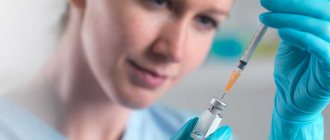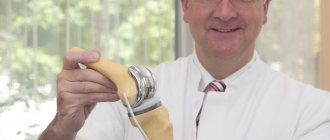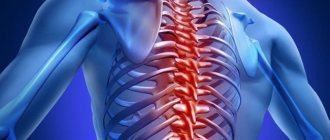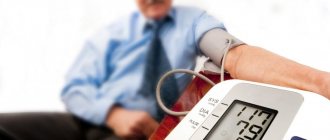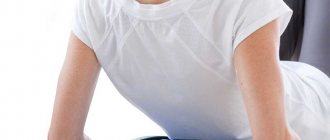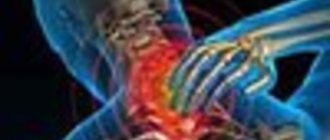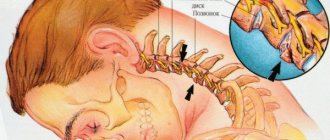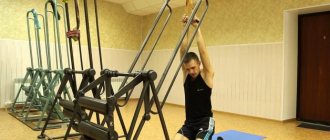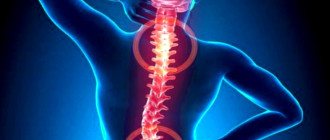General description of the disease
Osteochondrosis is a back disease that is characterized by degenerative-dystrophic changes in the spine. The disease affects the intervertebral discs, adjacent vertebral joints, and the ligaments of the spine.
Causes and prerequisites for the development of osteochondrosis
uneven load on the spine, psycho-emotional blocks, prolonged static and tense postures (driving a car or working at a computer), persistent muscle spasm, heredity, overload of the spine (carrying heavy objects, obesity), injuries and damage to the spine.
Symptoms of osteochondrosis
Typically these include: disturbances in the sensitivity of the back, pain of various types (headache, heart, lumbar and back pain), disruption of the functioning of internal organs, increased pain during physical activity, sneezing and coughing, sudden movements, lifting weights, muscle atrophy, a feeling of aching or numbness in the limbs. Symptoms of osteochondrosis depend on the stage of its development and the type of disease:
- with cervical osteochondrosis: vertebral artery syndrome (dizziness, flashing of colored spots and “spots” before the eyes), headache, which intensifies with neck movements and in the morning, loss of consciousness, pain in the shoulders and arms with light exertion;
- with thoracic osteochondrosis: pain in the thoracic spine, intercostal neuralgia, pain in the heart;
- with lumbar osteochondrosis: pain in the lumbar region, radiating to the sacrum, legs, pelvic organs, numbness of the thighs, legs and feet, spasm of the leg arteries.
General rules
Osteochondrosis of the spine is an inflammatory and degenerative disease that affects the intervertebral discs and ligaments of the spine, manifested by pain in the affected part of the spine and neurological symptoms ( lumbodynia , cervicalgia , cervical/lumbar radiculitis , ischioradiculitis ).
It occurs in both men and women. Treatment of stages 1 and 2 of the disease is conservative, including medicinal and non-medicinal methods. Non-drug methods include exercise therapy, physiotherapeutic procedures, massage, manual therapy, hydrotherapy, traction, immobilization and orthopedic correction, as well as nutritional correction. Obviously, in the presence of already formed degenerative changes in the structure of the spine, nutritional correction cannot cause reverse processes. The main task of proper nutrition for spinal osteochondrosis is to provide the body with all macro/micronutrients that improve the nutrition of cartilage tissue and stimulate its synthesis, which helps slow down degenerative processes.
There is no special diet for the treatment of osteochondrosis and exacerbations of neurological manifestations. A diet for osteochondrosis of the cervical spine should, first of all, be physiologically complete and comply with the principles of rational nutrition, rich in vitamins and minerals. The energy value of the daily diet should, on average, correspond to the amount of daily energy expenditure and not be excessive. For osteochondrosis of any part of the spine (cervical, lumbar, thoracic), the diet should include foods containing natural chondroprotectors .
Diet No. 15 according to Pevzner, which contains all the necessary macronutrients, minerals and an increased amount of fat/water-soluble vitamins and carbohydrates, can be taken as the basis for therapeutic nutrition for cervical and lumbar osteochondrosis for patients with normal body weight The energy value of the diet is 2600-2700 kcal (85-90 g protein, 90-95 g fat and 350-400 g carbohydrates).
It is necessary to consume up to 2 l/day of free fluid, since its lack in the body leads to drying out and loss of elasticity of the intervertebral discs and subsequent destruction. Salt 5-8 g/day. It is allowed to include many foods in the diet with the exception of concentrated broths and first courses based on them, fatty meats and fish, and refractory fats.
Margarine, fatty and salty meat products (smoked meats, canned food), as well as vegetables and fruits with rough skin containing a lot of fiber (beans, corn, lentils, soybeans, beans, chickpeas) and essential oils (garlic, turnips, celery, parsley) are subject to restrictions. , marjoram, tarragon, radish, basil, radish). It is necessary to exclude coffee and strong black tea from the diet, and limit the intake of alcoholic beverages.
In case of osteochondrosis of the lumbar and cervical regions, special attention should be paid to the vitamin and mineral component of the diet. To restore the structure of the cartilage of the intervertebral discs, it is important to supply the body with the entire spectrum of essential vitamins ( A , D , PP , B , C ) and trace elements - calcium, potassium, manganese, phosphorus, magnesium in sufficient quantities. To do this, your diet must include cheeses and dairy products, as well as sesame seeds, almonds, rose hips, watercress, and legumes, which contain a lot of calcium. Vitamin D , found in egg yolks, sea fish, and butter, improves the absorption of calcium For complete absorption of calcium, the body needs a sufficient amount of magnesium, which is present in foods such as avocados, sunflower seeds, spinach, cucumbers, and nuts.
To maintain the structure of the bone tissue of the spine, it is important to include foods rich in phosphorus in the diet - white and cauliflower, bran, peas, soybean pods, lettuce, different types of fish, natural cheeses. Manganese is present in sufficient quantities in chicken meat, cheeses, egg yolks, seaweed, potato peels, celery, onions, walnuts, almonds, chestnuts, and bananas.
The diet must contain foods containing fat-soluble vitamins A and E - animal liver, chicken eggs, fish, vegetable oils, fish oil, peaches.
Vitamin C is found in large quantities in vegetables and fruits (sweet peppers, white and cauliflower, garden greens, rose hips, citrus fruits, currants, apples, pears, plums, avocados, gooseberries), which should occupy a significant part of the daily diet. Meat products, cereals, rye bread, seafood, eggs, mushrooms, fish, milk, and cheeses are rich in B vitamins. However, if possible, it is recommended to consume some of the products fresh, since heat cooking of products significantly reduces the content of nutrients in them.
In case of spinal osteochondrosis, the diet must include foods and dishes containing natural chondoprotectors - a class of complex carbohydrates ( glucosamine , chondroitin ) that have a stimulating effect on the synthesis of cartilage tissue and slow down the processes of its degeneration. Glucosamine is found mainly in cartilage, chicken meat, beef, and hard cheeses. Chondroitin is found in animal tendons and cartilage, skin, and especially in large quantities in red fish (salmon, trout, salmon). Therefore, your diet should include dishes prepared on their basis - jellied fish, jelly, jelly and jelly. It is important to follow a split diet (up to 5-6 times a day) and not to overeat.
A diet for lumbar osteochondrosis for patients with increased body weight should be aimed, first of all, at normalizing weight, since additional loads on the spine increase pressure on the intervertebral discs and compress the surrounding tissues and nerve roots, disrupt their trophism and contribute to faster “wear and tear” and drying of cartilage discs. To do this, in a diet with a normal protein content (80 g), fats (up to 50 g) and carbohydrates are limited to 250-300 g, depending on the amount of extra pounds. Products containing easily digestible carbohydrates - sugar, jam, honey, white bread, pastries, sweets, cream-containing products, as well as products containing animal fats - fatty meat, animal and cooking fats, smoked meats, duck, goose, high-calorie dairy products are subject to restrictions. - sour cream and high-fat cream, butter margarine, mayonnaise. The consumption of soy is limited to 5-6 g/day and the consumption of salty foods (canned vegetables, pickles, canned food), as well as spices and seasonings that stimulate appetite - onions, ketchup, celery, ground black pepper, vinegar, mustard, horseradish, garlic . After normalizing your weight, you can switch to a general diet.
What is osteochondrosis
Lumbar osteochondrosis is a degenerative pathology of the vertebrae in the lumbar region. The disease affects not only the spine, but also the neurovascular system. Symptoms are divided into vertebral and non-vertebral syndromes. In the first case, the symptoms appear only on the vertebrae, but in the second they affect the nerves and blood vessels.
Authorized Products
- The diet is allowed to include various soups and other first courses (borscht, rassolnik, cabbage soup, solyanka) cooked in weak, non-concentrated broths.
- Recommended rye or grain bread made from coarse flour.
- Red meat and poultry should be lean and can be prepared in any way.
- It is recommended to include white and red fish, seafood, and chicken eggs in any form in your diet.
- As a side dish you can eat various cereals and rice, pasta made from durum flour.
- Be sure to consume fermented milk drinks (kefir, yogurt, acidophilus), cottage cheese, milk, hard cheeses, and sour cream every day.
- The diet should include a wide variety of vegetables, both raw and after cooking. It is necessary to add ground sesame seeds and flax seeds to vegetable salads. It is important to include various types of vegetable oils and butter in your diet.
- The presence in the diet of such dishes as jellied fish, jelly and gelatin-based dishes - jelly and fruit jellies is mandatory.
- For drinks, it is recommended to consume compotes, rosehip infusion, herbal decoctions, green tea, freshly squeezed fruit and vegetable juices, and still mineral water.
Table of permitted products
| Proteins, g | Fats, g | Carbohydrates, g | Calories, kcal | |
Vegetables and greens | ||||
| zucchini | 0,6 | 0,3 | 4,6 | 24 |
| cabbage | 1,8 | 0,1 | 4,7 | 27 |
| cauliflower | 2,5 | 0,3 | 5,4 | 30 |
| carrot | 1,3 | 0,1 | 6,9 | 32 |
| cucumbers | 0,8 | 0,1 | 2,8 | 15 |
| beet | 1,5 | 0,1 | 8,8 | 40 |
| pumpkin | 1,3 | 0,3 | 7,7 | 28 |
Fruits | ||||
| apricots | 0,9 | 0,1 | 10,8 | 41 |
| oranges | 0,9 | 0,2 | 8,1 | 36 |
| watermelon | 0,6 | 0,1 | 5,8 | 25 |
| bananas | 1,5 | 0,2 | 21,8 | 95 |
| pears | 0,4 | 0,3 | 10,9 | 42 |
| melon | 0,6 | 0,3 | 7,4 | 33 |
| lime | 0,9 | 0,1 | 3,0 | 16 |
| lemons | 0,9 | 0,1 | 3,0 | 16 |
| tangerines | 0,8 | 0,2 | 7,5 | 33 |
| plums | 0,8 | 0,3 | 9,6 | 42 |
| apples | 0,4 | 0,4 | 9,8 | 47 |
Berries | ||||
| grape | 0,6 | 0,2 | 16,8 | 65 |
| strawberry | 0,8 | 0,4 | 7,5 | 41 |
| sea buckthorn | 1,2 | 5,4 | 5,7 | 82 |
| currant | 1,0 | 0,4 | 7,5 | 43 |
Mushrooms | ||||
| mushrooms | 3,5 | 2,0 | 2,5 | 30 |
Nuts and dried fruits | ||||
| nuts | 15,0 | 40,0 | 20,0 | 500 |
| raisin | 2,9 | 0,6 | 66,0 | 264 |
| sesame | 19,4 | 48,7 | 12,2 | 565 |
| sunflower seeds | 20,7 | 52,9 | 3,4 | 578 |
| pumpkin seeds | 24,5 | 45,8 | 4,7 | 556 |
| dates | 2,5 | 0,5 | 69,2 | 274 |
Cereals and porridges | ||||
| buckwheat (kernel) | 12,6 | 3,3 | 62,1 | 313 |
| cereals | 11,9 | 7,2 | 69,3 | 366 |
| corn grits | 8,3 | 1,2 | 75,0 | 337 |
| pearl barley | 9,3 | 1,1 | 73,7 | 320 |
| millet cereal | 11,5 | 3,3 | 69,3 | 348 |
| white rice | 6,7 | 0,7 | 78,9 | 344 |
| barley grits | 10,4 | 1,3 | 66,3 | 324 |
Bakery products | ||||
| bagels | 16,0 | 1,0 | 70,0 | 336 |
| buns | 7,2 | 6,2 | 51,0 | 317 |
| butter horns | 8,3 | 12,1 | 50,5 | 345 |
| Rye bread | 6,6 | 1,2 | 34,2 | 165 |
Confectionery | ||||
| jam | 0,3 | 0,2 | 63,0 | 263 |
| jam | 0,3 | 0,1 | 56,0 | 238 |
| jelly | 2,7 | 0,0 | 17,9 | 79 |
| fruit and berry marmalade | 0,4 | 0,0 | 76,6 | 293 |
| oatmeal cookies | 6,5 | 14,4 | 71,8 | 437 |
Raw materials and seasonings | ||||
| honey | 0,8 | 0,0 | 81,5 | 329 |
| sugar | 0,0 | 0,0 | 99,7 | 398 |
| milk sauce | 2,0 | 7,1 | 5,2 | 84 |
| sour cream sauce | 1,9 | 5,7 | 5,2 | 78 |
Dairy | ||||
| milk | 3,2 | 3,6 | 4,8 | 64 |
| kefir | 3,4 | 2,0 | 4,7 | 51 |
| sour cream | 2,8 | 20,0 | 3,2 | 206 |
| curdled milk | 2,9 | 2,5 | 4,1 | 53 |
| acidophilus | 2,8 | 3,2 | 3,8 | 57 |
| yogurt | 4,3 | 2,0 | 6,2 | 60 |
Cheeses and cottage cheese | ||||
| cheese | 24,1 | 29,5 | 0,3 | 363 |
| cottage cheese | 17,2 | 5,0 | 1,8 | 121 |
Meat products | ||||
| beef | 18,9 | 19,4 | 0,0 | 187 |
| veal | 19,7 | 1,2 | 0,0 | 90 |
| rabbit | 21,0 | 8,0 | 0,0 | 156 |
Bird | ||||
| chicken | 16,0 | 14,0 | 0,0 | 190 |
| turkey | 19,2 | 0,7 | 0,0 | 84 |
Eggs | ||||
| chicken eggs | 12,7 | 10,9 | 0,7 | 157 |
Fish and seafood | ||||
| Red caviar | 32,0 | 15,0 | 0,0 | 263 |
| canned fish | 17,5 | 2,0 | 0,0 | 88 |
Oils and fats | ||||
| butter | 0,5 | 82,5 | 0,8 | 748 |
| linseed oil | 0,0 | 99,8 | 0,0 | 898 |
| olive oil | 0,0 | 99,8 | 0,0 | 898 |
| sunflower oil | 0,0 | 99,9 | 0,0 | 899 |
| ghee | 0,2 | 99,0 | 0,0 | 892 |
Non-alcoholic drinks | ||||
| mineral water | 0,0 | 0,0 | 0,0 | — |
| lingonberry juice | 0,1 | 0,0 | 10,7 | 41 |
| green tea | 0,0 | 0,0 | 0,0 | — |
Juices and compotes | ||||
| compote | 0,5 | 0,0 | 19,5 | 81 |
| apricot juice | 0,9 | 0,1 | 9,0 | 38 |
| jelly | 0,2 | 0,0 | 16,7 | 68 |
| carrot juice | 1,1 | 0,1 | 6,4 | 28 |
| tomato juice | 1,1 | 0,2 | 3,8 | 21 |
| pumpkin juice | 0,0 | 0,0 | 9,0 | 38 |
| rose hip juice | 0,1 | 0,0 | 17,6 | 70 |
| * data is per 100 g of product | ||||
Diagnostics
To make a diagnosis, you should contact a neurologist. Treatment of lumbar osteochondrosis without a neurologist's opinion is not only ineffective, but also dangerous. Depending on the clinical situation, the doctor will refer the patient for MRI, ultrasound, or CT. Our clinic has the required diagnostic facilities for comprehensive detection and treatment of pathology.
Fully or partially limited products
In the diet for osteochondrosis of the spine, fatty concentrated broths, fatty red meat, refractory animal fats, poultry (duck goose), coffee and drinks containing caffeine (strong tea, chocolate) should be excluded. The consumption of sweet foods and alcohol-containing drinks is limited.
Table of prohibited products
| Proteins, g | Fats, g | Carbohydrates, g | Calories, kcal | |
Vegetables and greens | ||||
| spicy vegetables | 2,8 | 0,5 | 5,3 | 36 |
| canned vegetables | 1,5 | 0,2 | 5,5 | 30 |
| swede | 1,2 | 0,1 | 7,7 | 37 |
| bulb onions | 1,4 | 0,0 | 10,4 | 41 |
| canned cucumbers | 2,8 | 0,0 | 1,3 | 16 |
| radish | 1,2 | 0,1 | 3,4 | 19 |
| white radish | 1,4 | 0,0 | 4,1 | 21 |
| turnip | 1,5 | 0,1 | 6,2 | 30 |
| celery | 0,9 | 0,1 | 2,1 | 12 |
| canned tomatoes | 1,1 | 0,1 | 3,5 | 20 |
| horseradish | 3,2 | 0,4 | 10,5 | 56 |
| garlic | 6,5 | 0,5 | 29,9 | 143 |
Raw materials and seasonings | ||||
| mustard | 5,7 | 6,4 | 22,0 | 162 |
| ketchup | 1,8 | 1,0 | 22,2 | 93 |
| mayonnaise | 2,4 | 67,0 | 3,9 | 627 |
| ground black pepper | 10,4 | 3,3 | 38,7 | 251 |
| vinegar | 0,0 | 0,0 | 5,0 | 20 |
Meat products | ||||
| pork | 16,0 | 21,6 | 0,0 | 259 |
| salo | 2,4 | 89,0 | 0,0 | 797 |
| bacon | 23,0 | 45,0 | 0,0 | 500 |
Bird | ||||
| smoked chicken | 27,5 | 8,2 | 0,0 | 184 |
| duck | 16,5 | 61,2 | 0,0 | 346 |
| smoked duck | 19,0 | 28,4 | 0,0 | 337 |
| goose | 16,1 | 33,3 | 0,0 | 364 |
Fish and seafood | ||||
| smoked fish | 26,8 | 9,9 | 0,0 | 196 |
Oils and fats | ||||
| creamy margarine | 0,5 | 82,0 | 0,0 | 745 |
| animal fat | 0,0 | 99,7 | 0,0 | 897 |
| cooking fat | 0,0 | 99,7 | 0,0 | 897 |
| * data is per 100 g of product | ||||
Symptoms of lumbar osteochondrosis
Vertebral syndrome:
- rachiocampsis;
- lumbar muscle tension;
- decreased mobility of the vertebrae in the lumbar region;
- painful sensations.
Extravertebral symptoms can be reflex and radicular.
Reflex syndrome is accompanied by:
- constant or sharp pain in the lumbar region after physical activity;
- morning stiffness and decreased mobility due to constant muscle tension;
- shooting in the lower back or leg;
- numbness, tingling or burning, as well as decreased sensitivity of the lower extremities;
- disturbances in the functioning of the intestines and bladder, as well as in sexual function;
- irritability, sudden mood swings and fatigue.
Radicular symptoms arise due to the effect of lumbar osteochondrosis on the nervous system. These include:
- muscle weakness;
- decreased sensitivity;
- radicular pain;
- decreased reflexes or their complete loss.
Reviews and results
Reviews among patients with osteochondrosis of different parts of the spine vary significantly. Apparently, this is explained by the stage of the disease, the severity of neurological symptoms and the methods of conservative treatment used, and their effectiveness in each specific case.
- “... I have been suffering from osteochondrosis for more than 15 years. Exacerbations occur periodically, more often after physical activity or during a cold. The doctor recommends proper nutrition and treatment. I mainly save myself with various NSAID drugs. Traction helps a lot, I do special exercises for the spine. I try to monitor my weight, I tried to switch to a vegetarian menu, but the doctor did not recommend it, as well as fasting treatment. Therefore, in nutrition I focus on reducing calories, fortifying and enriching the diet with minerals”;
- “...Lumbar radiculitis is my scourge. Diclofenac injections and massages help. I don’t follow any diet, I just watch my weight and that’s it. But on the advice of a doctor, I take 60 tablets of a vitamin-mineral complex 2-3 times a year.”
Existing techniques
Once every 2-3 months, patients with osteochondrosis are recommended to cleanse the body with the help of special diets. This principle of therapeutic nutrition also helps to restore damaged bone and cartilage tissues, strengthen muscles and ligaments. But such diets should be used only after consultation with a vertebrologist or neurologist.
Salt-free diet
To prevent swelling and relapse of pathology, it is better to add salt to food on the table, and not during cooking. This allows you to control the amount of salt you consume, and subsequently completely abandon it. But first, once a month you should not add salt to food at all throughout the body, without changing your diet.
Rice diet
Before starting the diet, you need to prepare six containers with a volume of at least 0.5 liters. Place 2 tablespoons of washed rice in the first one and add cold water so that the liquid rises 10 cm above the grain. The next morning, repeat the procedure with another container. After filling all the jars, you can start cleaning. To do this, you need to drain the liquid from the first container, rinse the rice with water and eat it for breakfast. If you have osteochondrosis, you should not stick to such a diet for more than a week.
Nutritional Features
The diet for osteochondrosis of the cervical spine should provide the patient with all the necessary vitamins and minerals. Daily nutrition for women cannot exceed 2000 kcal, for men - 2700 kcal. Food must contain proteins, which are found in sufficient quantities in poultry, fish, beef, cereals, and dairy products.
When osteochondrosis worsens, a salt-free diet will help. The effect will be noticeable already at the initial stage. Dried kelp, spirulina or chlorella (seaweed) can help replace sodium. The course should not exceed 2 weeks. Contraindications include pregnancy, heart and vascular diseases.
Nutrition for osteochondrosis of the lumbar spine should include more calcium. To do this, you need to consume dairy products twice a day and include bean porridge in your menu. Cottage cheese is good for the lumbosacral region. 100 grams of this healthy product contains 150 mg of calcium.
Nutrition for osteochondrosis of the thoracic spine should contain sufficient amounts of vitamin B and D. They will help improve the conduction of nerve impulses to the brain and strengthen the walls of blood vessels.
Diet for osteochondrosis is the basis of proper treatment. Proper nutrition increases the effectiveness of drug therapy, reduces side effects from drug exposure, strengthens the immune system, and helps absorb essential vitamins and minerals.
Medications
Drug treatment of osteochondrosis of the thoracic spine is carried out by taking tablets, a course of injections, suppositories or using ointments/gels.
Treatment with medications is carried out over several months. In the absence of positive changes, the disease is eliminated through surgery.
Anti-inflammatory nonsteroidal drugs (PVNS)
They are used to reduce pain and relieve inflammatory processes occurring in the nerve roots. Among the most effective drugs are:
- Artradol;
- Nimesulide;
- Diclofenac.
Self-administration of PVNS is extremely dangerous to health and can cause irreparable harm. Specialist consultation is required.
Glucocorticosteroids
This category of drugs for osteochondrosis of the thoracic region includes Dexamethasone and Prednisol.
Due to the fact that the drugs are hormonal, their use must be agreed upon with the attending physician. Otherwise, irreparable harm may be caused to the body.
Diuretics
Diuretics that relieve swelling in the presence of pinched nerve roots. Drugs of this type include Furosemide and Diacarb.
Vitamin complexes
Taking vitamins improves the metabolic processes occurring in the nervous tissue.
In order to restore high-quality metabolism, patients are prescribed B vitamins, as well as Pentoxifylline and Thioctic acid.
Chondroprotectors
Medicines, the use of which ensures the restoration of elasticity and shock-absorbing functions of the intervertebral discs.
One of the most effective remedies is Artracam.
The intensity and dosage of taking medications for thoracic osteochondrosis is determined taking into account the stage of development of the disease.
Antispasmodics
They help relax the muscle frame and help get rid of the problem of constant spasms, starting the recovery process of thoracic osteochondrosis.
The most effective include:
- Mydocalm;
- Buscopan;
- Eufillin.
